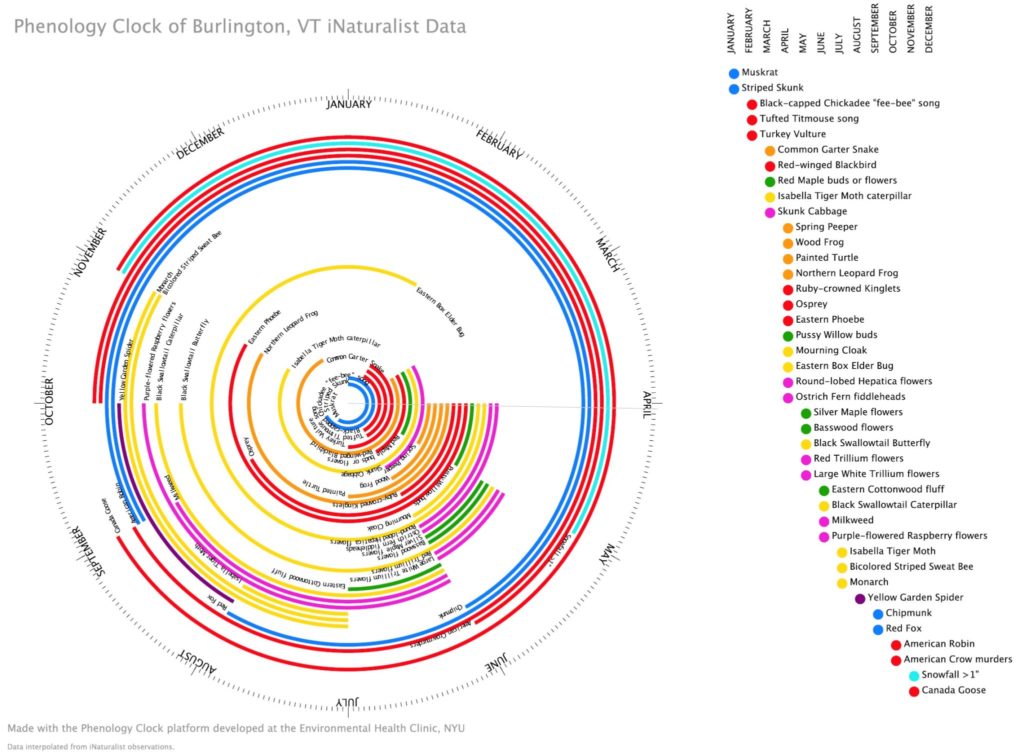2020 Burlington Phenology Clock and iNaturalist Observing
What is a phenology clock?
A phenology clock is a circular graph that shows when selected species are found in a specific place over the course of the year.
The 2020 Burlington Phenology Clock Project hopes to document when species come and go in our city as a way of measuring the seasons. It isn’t possible without YOUR help! Through a program called iNaturalist, anyone can submit photos or sound bites of species they’ve seen, recording when, where, and what they think they saw. Once you have an account, you can upload observations online or through the iNaturalist app. Burlington Wildways then can summarize the observations from iNaturalist to update our phenology clock. A new clock can be made every year to compare when species appear in the city, if certain species overlap and create a food chain, and how climate change and other factors may be changing the ecology and biodiversity of Burlington.
How do I use iNaturalist?
iNaturalist can be used online at iNaturalist.org and through the iNaturalist app. You will need to sign up for an account here:
https://www.inaturalist.org/signup
If you already have photos or sound bites recorded on a computer, you can upload them to iNaturalist.org. This short video demonstrates how to use the website.
If you are in the field, the quickest way to submit observations to iNaturalist is through the app. This short video shows you how to use the app.
Identifying Observations of Others (Online)
Identifying species in observations that other people have submitted to iNaturalist is a step that is helpful for everyone in the community. Observations often do not list the specific species found in the photo or sound clip, so other people with knowledge about birds, bugs, or whatever is in the observation can help by adding in their best ID whether it is just a kingdom like plants, a genus, or a specific species like the Ostrich Fern. Even when the observer thinks they know the species and marks their observation appropriately, iNaturalist still waits to label their observation as legitimate enough to be “Research Grade” until at least one other person agrees with them. Watch the video below to learn how to use the Identify process when in iNaturalist online.
2020 Burlington Phenology Clock Species List
iNaturalist users have found over 1,600 species so far, just in Burlington! While finding new species is always exciting and encouraged, our phenology project is only tracking a few key species in the city, and in some cases only when they exhibit seasonal characteristics. Feel free to submit any species you find to iNaturalist, but know that we will only be using the following in our phenology clock:
Birds
- American Crow (groups only)
- American Robin
- Blackpoll Warbler
- Black-capped Chickadee (“Fee bee” song only)
- Canada Goose
- Eastern Phoebe
- Osprey
- Red-winged Blackbird
- Ruby-crowed Kinglets
- Tufted Titmouse (sound bites)
- Turkey Vulture
Trees/Shrubs
- Basswood (with flowers only)
- Eastern Cottonwood (with fluff only)
- Eastern White Pine (with green pollen only)
- Linden (with flowers only)
- Pussy Willow (with fuzzy buds only)
- Red Maple (with flowers only)
- Silver Maple (with flowers only)
Mammals
- American Beaver
- Eastern Chipmunk
- Muskrat
- Red Fox
- Striped Skunk
Amphibians and Reptiles
- Common Garter Snake
- Northern Leopard Frog
- Painted Turtle
- Spring Peeper
- Wood Frog
Insects
- Bicolored Striped Sweat Bee
- Black Swallowtail (caterpillar or butterfly)
- Eastern Box Elder Bug
- Isabella Tiger Moth (caterpillar or moth)
- Mourning Cloak (butterfly only)
Herbaceous Plants
- Common/Four-Leaved/Swamp Milkweed (with flowers only)
- Large White Trillium (with flowers only)
- Ostrich Fern (with fiddleheads only) **please do not pick**
- Red Trillium (with flowers only)
- Round-lobed Hepatica (with flowers only)
- Skunk Cabbage (with red-brown hoods only)
- Purple-flowered Raspberry (with flowers only)
Example Phenology Clock:

